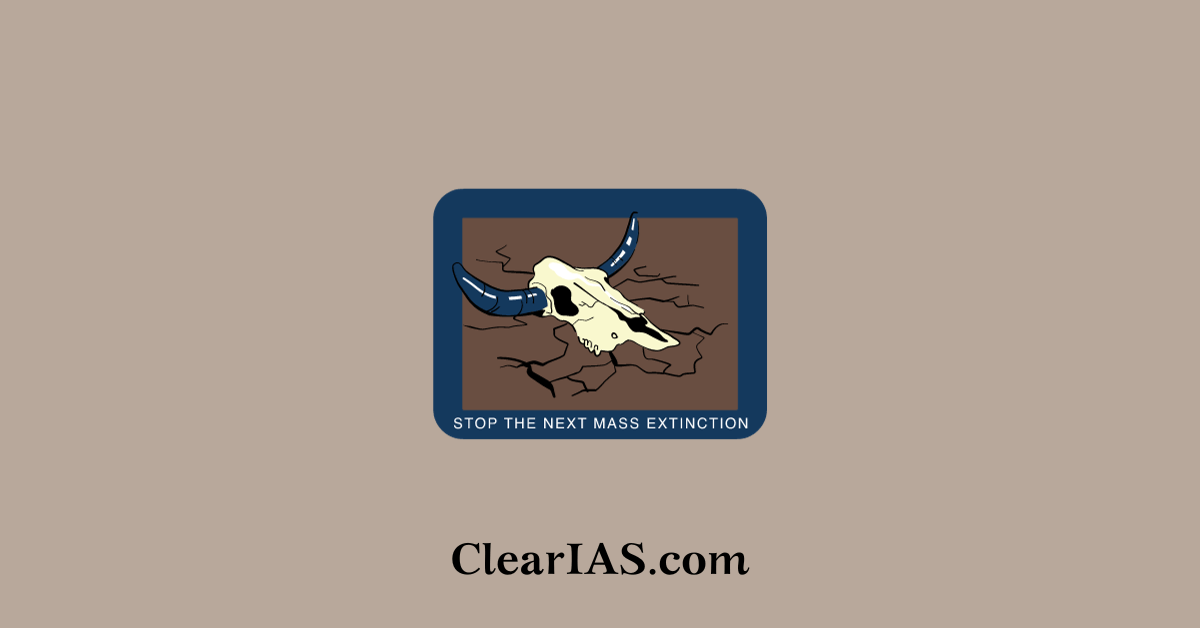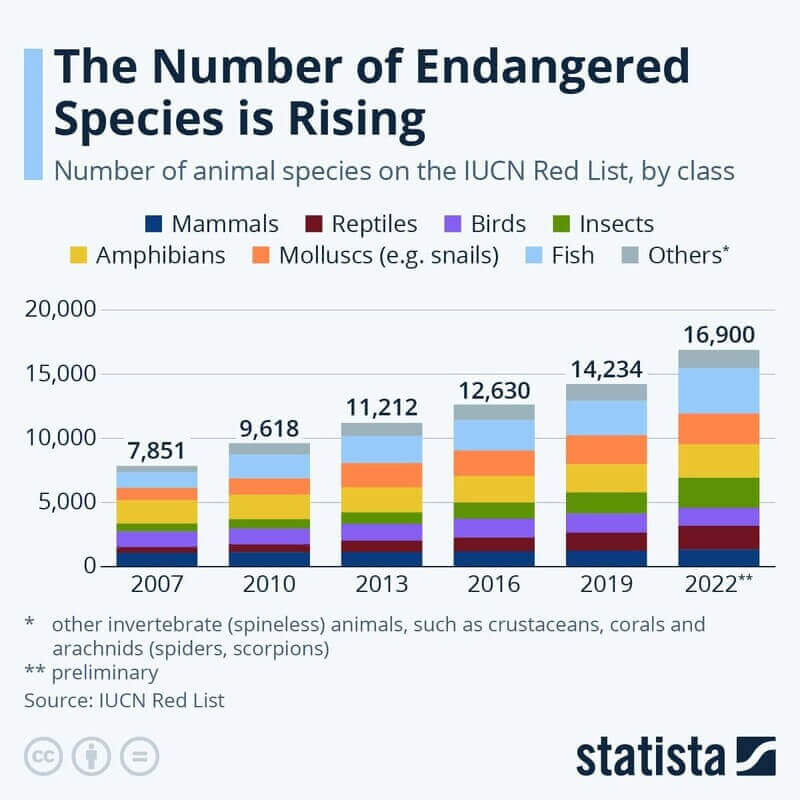
The Holocene extinction, often referred to as the Sixth Mass Extinction or Anthropocene Extinction, is an ongoing period of biodiversity loss marked by a significant decline in the diversity and abundance of various species on Earth. Read here to learn more.
Unlike previous mass extinctions, the Holocene extinction is primarily driven by human activities, particularly habitat destruction, overexploitation of resources, pollution, climate change, and the introduction of invasive species.
The term “Holocene” refers to the current geological epoch, which began approximately 11,700 years ago and continues to the present day.
Holocene Extinction
The primary driver of the Holocene extinction is human activity. The expansion of agriculture, urbanization, deforestation, industrialization, and other anthropogenic activities has led to widespread habitat destruction and fragmentation.
- Overexploitation: Overharvesting of natural resources, including overfishing, poaching, and hunting, has contributed to the decline of numerous species. Economic activities driven by human demand for food, medicine, and other products have led to the depletion of many populations.
- Habitat Loss and Fragmentation: The conversion of natural habitats into agricultural land, urban areas, and infrastructure projects has significantly reduced the available living space for many species. Habitat fragmentation isolates populations, making it challenging for them to survive and reproduce.
- Climate Change: Human-induced climate change is altering temperature patterns, precipitation, and ecosystems. These changes can lead to shifts in species distribution, disrupt ecological relationships, and exacerbate the vulnerability of certain species.
- Pollution: Pollution from industrial activities, agriculture, and waste disposal has contaminated air, water, and soil. Chemical pollutants and plastic waste, in particular, have harmful effects on ecosystems and wildlife.
- Invasive Species: The introduction of non-native species to new environments, intentionally or accidentally, can outcompete or prey upon native species, leading to their decline or extinction.
Currently, 40% of all land has been converted for food production. Agriculture is also responsible for 90% of global deforestation and accounts for 70% of the planet’s freshwater use, devastating the species that inhabit those places by significantly altering their habitats.
It’s evident that where and how food is produced is one of the biggest human-caused threats to species extinction and our ecosystems.
- Unsustainable food production and consumption are significant contributors to greenhouse gas emissions that are causing atmospheric temperatures to rise, wreaking havoc across the globe.
- The climate crisis is causing everything from severe droughts to more frequent and intense storms.
- It also exacerbates the challenges associated with food production that stress species, while creating conditions that make their habitats inhospitable.
- Increased droughts and floods have made it more difficult to maintain crops and produce sufficient food in some regions.
- The intertwined relationships among the food system, climate change, and biodiversity loss are placing immense pressure on our planet.
Why is the Holocene extinction worrying?
Species do not exist in isolation; they are interconnected. A single species interacts with many other species in specific ways that produce benefits to people, like clean air, clean water, and healthy soils for efficient food production.
When one species goes extinct in an ecosystem or its population numbers decline so significantly that it cannot sustain its important function, other species are affected, impacting the way the ecosystem functions and the benefits it provides.
Currently, the species extinction rate is estimated between 1,000 and 10,000 times higher than natural extinction rates, the rate of species extinction that would occur if humans were not around.
While extinctions are a normal part of the evolutionary process, the current rates of species population decline and species extinction are high enough to threaten important ecological functions that support human life on Earth, such as a stable climate, predictable regional precipitation patterns, and productive farmland and fisheries.
Examples of recent extinctions

The International Union for Conservation of Nature (IUCN) characterizes ‘recent’ extinction as those that have occurred past the cut-off point of 1500, and at least 875 plant and animal species have gone extinct since that time and 2009.
While it’s challenging to provide a comprehensive list of all affected species, here are some examples of species that have been particularly impacted by the Holocene extinction:
Amphibians:
- Harlequin Frog: Many species of harlequin frogs, once abundant in Central and South America, have experienced dramatic declines due to a combination of habitat loss and the spread of the chytrid fungus.
Birds:
- Passenger Pigeon: The passenger pigeon was once one of the most abundant bird species in North America but became extinct in the early 20th century due to habitat destruction and overhunting.
- California Condor: Facing threats from lead poisoning, habitat destruction, and hunting, the California condor is one of the most critically endangered bird species.
Mammals:
- Northern White Rhinoceros: The northern white rhinoceros is functionally extinct, with only two surviving females. Poaching for their horns and habitat loss have contributed to their decline.
- Sumatran Orangutan: Orangutans, particularly the Sumatran orangutan, face severe threats from habitat destruction, primarily due to palm oil plantations.
- Javan Tiger: The Javan tiger became extinct in the mid-20th century due to habitat loss and hunting.
- Pinta Island Tortoise: Lonesome George, the last known individual of this tortoise species, died in 2012, marking the species’ extinction.
Reptiles:
- Vaquita: The vaquita, a small porpoise species, is critically endangered, with a population decline primarily attributed to bycatch in illegal gillnets.
Insects:
- Monarch Butterfly: The monarch butterfly population has declined due to habitat loss, pesticide use, and climate change, affecting their migratory patterns.
Fish:
- Chinese Paddlefish: Declared extinct in 2020, the Chinese paddlefish was a large freshwater species that declined due to overfishing, habitat degradation, and dam construction.
Plants:
- Franklinia Tree: This tree species, native to the southeastern United States, is believed to be extinct in the wild due to habitat loss.
Marine Species:
- Great Barrier Reef Corals: Coral reefs, including those in the Great Barrier Reef, are facing significant threats from climate change, coral bleaching, and ocean acidification.
Efforts to curb the sixth mass extinction
- Paris Agreement: We can ramp up our commitments to cutting carbon emissions under the Paris Agreement and limit global warming to 1.5 degrees Celsius.
- Kunming-Montreal Agreement: The global fraternity needs to put more effort into conserving at least 30% of lands, inland waters, and oceans worldwide.
De-extinction
De-extinction reverses plant and animal extinctions by creating new proxy versions of previously lost species. Conservationists frame de-extinction as “deep ecological enrichment” or restoring ecosystem functions lost through the extinctions of keystone species, which leave an ecological void by their absence.
This idea is the motivation for de-extinction projects: releasing resurrected animals into suitable habitats to increase biodiversity and restore ecosystem resilience. Assisted breeding, cloning, and genome editing are species restoration methods undertaken with the goal of re-establishing the dynamic processes that produce healthy ecosystems and restore biodiversity.
To de-extinct species, there are established research methods which include assisted breeding, cloning, and genetic engineering.
- Assisted breeding uses the principles of biobanking and assisted reproductive technologies to help restore species.
- Assisted reproductive scientists have highly characterized assisted breeding technologies in model species. However, non-model species have not been characterized at all, and this set includes many critically endangered species. These technologies enable scientists to increase overall population fitness and heterozygosity within fragmented populations.
- One of the best examples of successful assisted reproductive technologies (ART) for species with declining populations is the Northern White Rhino project, which has been underway for decades and continues today. In projects such as these, scientists retrieve and preserve gametes (oocytes and sperm) from populations at the brink of extinction.
- Cloning is another option useful for continuing a species, but not for returning or bringing back a lost one.
- Genome editing and synthetic genomics, using tools like CRISPR, are addressing de-extinction with positive results.
Conclusion
The Holocene extinction underscores the urgency of addressing human-induced threats to biodiversity and implementing effective conservation strategies to ensure the survival of diverse species and the health of ecosystems.
-Article by Swathi Satish






Leave a Reply